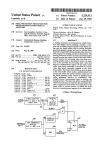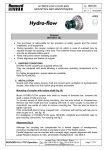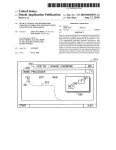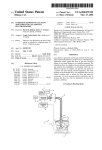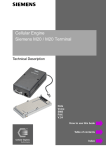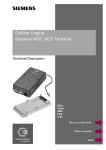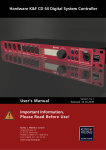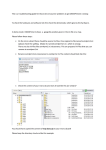Download Color television window expansion and overscan correction for high
Transcript
Illllllllllllllllllllllllllllllllllllllllllllllllllllllllllllllllllllllllll US005119082A United States Patent [19] [11] [45] Lumelsky et a]. [54] 5,119,082 Date of Patent: Jun. 2, 1992 COLOR TELEVISION WINDOW EXPANSION AND OVERSCAN OTHER PUBLICATIONS CORRECTION FOR HIGH-RESOLUTION “Digital Image Processing", by Gregory A. Baxes, pp. RASTER GRAPHICS DISPLAYS l60—16l, 1984. Inventors: Leon Lumelsky, Stamford, Conn.; Philips Co. SIGNETICS; Digital Video Signal Proces wig-Pan one‘ Sung Min Choi, White Plains; Alan w- Peevers, Peekskill, bOth of NY. [731 Patent Number: Assignee: Primary Examiner—Alvin E. Oberley Assistant Examiner-Amare Mengistu Attorney, Agent, or Firm-Roy R. Schlemmer; Jack M. Arnold International Business Machines Corporation, Armonk, NY. [57] ABSTRACT A video pixel presentation rate expansion circuit is pro vided for use with a high-resolution display system. The overall display system includes a high-resolution moni tor, a computer for providing control signals, including [21] Appl. No.: 415,012 [22] Fned: [51] Int. Cl.-‘ ....................... .. G096 1/06; H04N 9/74; video data at a rate controlled by said control signals HMN 7/01 and providing said data with a high-resolution monitor [52] US. Cl. .................................. .. for [58] _ 340/814; 353/22; 358/140 Field of Search ..................... .. 340/717, 814, 731; 358/22: 140 tion comprises means responsive to an expansion pat ‘cm generated by the computgr for changing the time base of the video pixel data read out of said frame buffer. Circuit includes means responsive to said expan sell 29 1989 ’ a high-resolution frame buffer for storing computer graphics and TV video images and reading out said References Cited [56] The expansion circuit of the present inven sion pattern for selectively repeating predetermined ‘ scan lines of said video display and for selectively re U‘S' PATENT DOCUMENTS peating certain pixel along a given scan line to match 4,063.280 12/1977 Hattorie et al. ............. .. 358/22 P1P 4.121.283 10/ 1978 Walker ----------- -340/703 HUI'SI ................................. .. the time base of the video data read out of said frame buffer to the time base of said high-resolution monitor. According to a preferred embodimen‘ of the invention 4'303'986 12/1931 L?“ ' the expansion circuit functions to modify the control 45]” ‘4 2/1982 walker ' 4.686.580 8/1937 4 746 979 5/1988 4,746,981 5/1988 signals which controls the read-out of the frame buffer . . . . . . . in a predetermined fashion without any additional video bum" Slorage means 358/451 358/22 340/717 4,82l.03l 4/1989 4,952,923 8/1990 Tamura ............................. .. 340/731 .. 340/73] Y 5 Claims, 5 Drawing Sheets Y A B C D E F' G H I (B-Y) A B C D E F G H I (R-Y) A B C D E F G H I A A B C C D E E F F G H I (B-Y)ABCDABCDEFGHI (R-Y)ABCDABCDEFGHI US. Patent June 2,1992 Sheet 1 of s TV IMAGE ‘ 5,119,082 HIGH RESOLUTION IMAGE Is FIG.I Id Q ____ Q f ___________________________ "I\ T l I I FIGZA f I v \ T I I I l Tv AIIHIES I I ' VISIBLE I PORTION I I I OF THE SCREEN ; : I L ' ' 390 480 J i I I il _____________________________ ., ) 6I2 PELS ACTIVE VIDEO 720 f a r/ /////////////////////7\ ;Z FIG. 2B j; / ACT'VE 4 480 LINES ? HI-RES VIDEO 4 0R HIGHER 2 § / / / 4 ’/f///////////////////// / \ 1 __AcIIvE VIDEOI64O PELS) OR HIGHER _' U.S. Patent June 2, 1992 Sheet 3 of 5 FIGAA PRIOR ART (B-Y) A (R-Y) A FIGAB (B-Y) A (R-Y) A 5,119,082 US. Patent June 2,1992 = Sheet 5 of5 1 1 ' 5,119,082 l 1 j 1 HXSR(0) VSCLK "-1 1- VIDEO DATA FROM 1 FRAME BUFFER ‘- A VCLK' D/A —L B '"_—L I ‘__1 , ‘_A ‘AFB VIDED DATA IN ~ ‘ ( 704 12 702 ’ E . ‘ D VIDED DATA BUT VIDEU SOURCE‘?> ' D ‘-—-—-‘ DATA LATCHED FIG 7 < C TU VIDEO A DISPLAY BUFFER VCLK’ -—-—----vscu< VBADDR VIDED BUFFER ADDRESS MULTIPLEXER 706 1 5,119,082 2 store away incoming pixels such that they are not lost, COLOR TELEVISION WINDOW EXPANSION AND OVERSCAN CORRECTION FOR HIGH-RESOLUTION RASTER GRAPHICS DISPLAYS or a mixture of both. It should be noted that as the magni?cation ratio increases, the image quality decreases. For example, when the magni?cation ratio is greater than two, the sharpness of the image is greatly reduced. Nevertheless, for current mixed video/graphics dis FIELD OF THE INVENTION The present invention relates generally to the ?eld of raster-scan graphic/video display systems. More partic ularly, it relates to such display systems which are capa play systems, the signi?cance of magnifying television images are of considerable importance. It is especially 0 important due to overscan problems which will be dis cussed below. In conventional commercial TV systems, the active portion of the raster (i.e., between blank signals) over ble of displaying interchangeably and/or concurrently both high-resolution graphic data and standard lower resolution TV video data on a high-resolution graphics monitor. scans the viewing area of the CRT to prevent a black border under worst-case conditions of variations in yoke sensitivity, anode voltage, etc. (See “Television Engineering Handbook", McGraw Hill Company, CROSS REFERENCE TO RELATED APPLICATIONS Window For a Video Display Unit“ discloses a video 1986, p.l3.l77). The overscan requirement for con sumer TV receivers goes somewhat higher than 10% of the full active area (See FIG. 2). This means that less than 90% of the active video image is usually shown on adapter architecture which provides for the expansion a TV screen. It is safe to say that video is overscanned US. patent application Ser. No. 314,998, ?led Feb. 24, 1989 of Lumelslty et al., Entitled “Color-Television of video data before it is stored in the video frame not more than 15%. This number is taken into consider ation when video is edited. buffer. It performs the requisite time-base or pixel pre On the other hand, high-resolution graphics monitors sentation rate expansion on the data at the input to the 25 video frame buffer and requires signi?cant extra hard ware to perform this operation contrasted with the present invention. BACKGROUND OF THE INVENTION do not use an overscan approach. Rather, they are un derscanned in order to present all graphics image pixels on the screen. In other words, it means that a black 30 The mapping of a television image on a graphics screen generally requires the image to be sampled and stored into a frame buffer. This allows a time base cor rection to be provided and, if necessary, a time com pression of the television image in order to show both television and graphics images on the same screen. If the image should be positioned in any arbitrary sized border always surrounds the image. The majority of applications in the multimedia area overlay a television image with graphics. The most widely used approach is to match 85% (in both linear directions) of the active television video with full lengths of the active graphics video line. With this ap proach a multimedia editor can be sure that whatever television movies or other materials are combined with graphics, the television image coordinates will corre spond to the graphics image coordinates with reason window on a graphics screen, it should be either scaled up or down. The image itself may not be a full screen able accuracy. and no unnecessary information, which image, but just an arbitrary window inside the full view image. This requires a translation and scaling operation screen. on the source image. Translation is a simple matter, and shall not be discussed in this paper. FIG. 1 shows how viding compatibility with previously developed multi might be overlooked during editing, will appear on the The overscan requirement is also important for pro media programs. For example, millions of dollars are a TV image window, Is, is transposed to a graphics 45 spent on such video processing programs such as IBM screen window, Id. Scaling up a television image on a graphics screen poses a much harder problem than scaling down. When scaling down a source image to a smaller destination image, it is possible to simply ignore pixels in the hori zontal direction and ignore scan lines in the vertical direction to achieve the correct sizing at the time of sampling. For example, to achieve a quarter sized win dow, every other pixel can be thrown away horizon tally, and every other scan line vertically. This can be 55 done simply at the time of sampling the source image into a frame buffer. However, for image expansion, it is necessary to either replicate pixels in a horizontal direc tion or replicate scan lines in a vertical direction to achieve the desired destination window size. This poses a problem as the bandwidth of the frame buffer needs to be increased. For example, if it were necessary to don ble the source image in both horizontal and vertical Infowindow, educational and presentation programs, where the overscan is taken into consideration. For a detailed description of the Infowindow product, refer ence should be made to one of the following publica tions describing same. 1) “Infowindow Guide to Operations" Order No. SK2T0297 and, 2) “Infowindow Enhanced Graphics Adapter: I-Iard ware Maintenance and Service Manual" Order No. SK2T0298, both are available from IBM Corp. Mechanicsburg, Pa. Any multimedia display adapter which does not address the overscan prob_ lem can not be used with Infowindow or Infowin dow-like programs. Moreover, such an adapter can not be used with the television material edited ?rst on standard television editing equipment. In the case of the IBM Infowindow product, a special enhanced graphics adapter (EGA) monitor is used directions, the bandwidth of the frame buffer required which provides for the overscan of video. It is, how~ to achieve the expansion needs to be quadrupled. The 65 ever, not a common graphics monitor. The approach of result of this is that either a faster frame buffer memory the present invention allows the use of a standard is necessary (notice that the speed of the frame buffer depends on the enlarging ratio), a FIFO deep enough to scan by a special sampling approach. Such a monitor graphics monitor, providing the television image over 3 5,119,082 4 bits of B-Y and 8 bits of R-Y). This further complicates expansion in the horizontal direction since due to the time multiplexing, it is not possible to simply replicate pixels. Notice that for chrominance, the smallest hori Zontal resolution is 4 pixels wide. It is necessary to keep architecture is disclosed and described in the publica tion “IBM lnfowindow Color Display" No. ZR23-6820 available from the IBM Corp. Mechanicsburg, Pa. One possible solution to achieving overscan is to choose a television image sampling frequency higher than that of the graphics video clock frequency. E.g., if the synchronization of the chrominance bits over a IBM PS/2 VGA has a video clock frequency of 25 Mhz which corresponds to 640 pixels on the active portion of period of four system clock cycles, and failing to do so horizontal scan line, the video sampling frequency should provide 640 pixels on the active portion of the all pixels that are out of synchronization. will result in corrupt color on the destination screen for Prior Art underscanned television horizontal scan line. Therefore, a total of 752 samples are required per scan line to achieve 640 pixels of underscanned samples (e.g., 7524859). Hence, 640 pixels of the sampled video image will correspond to 640 graphics pixels exactly, and the overscan requirement is satis?ed. This approach, however, does not work well when using the standard digital television sampling fre quency. Frequently, the television image is decoded and sampled using standard digital television techniques. It provides a cheaper solution, better image quality, and easier control over the brightness, sharpness, hue, etc. Unfortunately, the CCIR 60l-l recommendation for digital television encoding and transmission (See No video adapter architectures or hardware systems are known to the inventors which solve the above de 5 scribed problems using methods or apparatus at all simi lar to the herein disclosed expansion hardware mecha nism. SUMMARY AND OBJECTS It is a primary object of the present invention to pro vide a cost effective method and apparatus for expand ing video image data stored in a frame buffer in digital format in both the X and Y directions. It is a further object of the invention to provide such method and apparatus that operates strictly on the “Handbook of Recommended Standards and Proce 25 frame buffer output and provides certain control signals dures, International Teleproduction Society”, 1987, p. 62), which is widely used in the television industry, prescribes a sampling frequency of l3.5 Mhz. It gives a total of only 720 samples on a television scan line. With 15% overscan, it allows only 612 pixels as shown on FIG. 2. The present invention comprises a system for mapping 612 samples of the television image (pixels) to the output of the frame buffer for replicating prede termined scan lines and pixels but does not require any additional video buffering hardware. It is another object of the invention to provide such a method and apparatus wherein the only change in the video data path between the frame buffer and the moni tor is the provision of modi?ed clocks for accessing onto a larger number of graphics pixels. Clearly, the solution which preserves the sampling rate is to increase the number of samples after sampling has been done. Using the standard sampling rate of 13.5 Mhz, if the number of graphics pixels is 640, then the expansion ratio should be 640/604. However, this num both individual scan lines and pixels from the frame buffer wherein certain scan lines and pixels may be ber is not a power oftwo, and the expansion can not be drawings and claims. selectively repeated. Other objects features and advantages of the inven tion will be apparent from the following description of the invention as set forth in the appended speci?cation, done in a simple way, like replicating every pixel. An 40 The objects of the present invention are accom other consideration is that if the graphics adapter has plished in general by a video expansion circuit for use several modes with a different number of pixels in the with a high-resolution display system. The overall dis horizontal line, e.g., 320, 640, 720 pixels in the case of a play system includes a high-resolution monitor, a com VGA graphics adapter, (See, for example, IBM PS/2 puter for providing control signals,.a high-resolution Model 80 Technical Reference #68X2256 available frame buffer for storing computer graphics data and a from the IBM Corp. Mechanicsburg, Pa.) the scaling video frame buffer for storing TV video data and a ratio should be programmable. In a window environ ment, the expansion ratio should ideally be selectable to be any rational number de?ned by the size of the win dow. This situation is even more complicated by the spe mechanism for reading out the video data at a rate con ci?c coding scheme of digital television. The standard television coding schemes, either NTSC, PAL, or SECAM are all based on luminance/chrominance (Y /C) representations, rather than RGB, which reduces the bandwidth of the composite video signal and mem ory required to store the image frame. Furthermore, ‘ some digital television chips already in production use a time multiplexing technique to reduce the bandwidth required for chrominance information. For example, Philips provides digital television chips (See, for exam ple, "Digital Video Signal Processing" Philips Compo nears Manual N0. 9398 063 30011) in which luminance bit rate versus color bit rate is 4:]. Compared to 8 bits of trolled by said control signals and providing the video data to the high-resolution monitor for display. The expansion circuit of the present invention com prises a mechanism responsive to an expansion pattern generated by the computer for changing the rate of video pixel data read out of the frame buffer. The circuit includes such a mechanism responsive to the expansion pattern for selectively repeating predetermined scan lines of the video display and for selectively repeating certain pixels along a given scan line to allow the video data read out of the frame buffer to be expanded on the high-resolution monitor. ' According to a preferred embodiment of the inven tion the expansion circuit functions to modify the con trol signals which control the read-out of the frame buffer in a predetermined manner without any addi tional video buffer storage. In the simplest form of the luminance information per sampling clock, only 4 bits 65 invention the additional circuitry required comprises of chrominance are generated (2 bits for B-Y and 8 bits of R-Y) as shown in FIG. 3. Thus it takes four clock cycles to transmit a complete chrominance values (8 only two registers for holding the generated expansion patterns in the horizontal and vertical direction and two shift registers for receiving these patterns and process 5 5,119,082 6 ing same to alter the frame buffer clocks to achieve possible to achieve this effect by controlling the system replication of predetermined lines and pixels as deter mined from the said expansion patterns. clock to the D/A chip as explained below. Although implementation of the present invention may be accomplished in many different ways, e.g., by a BRIEF DESCRIPTION OF THE DRAWINGS counter, a shift register, or a random access memory, all operating under control of the desired expansion pat FIG. 1 is a diagramatic representation of the mapping tern a shift register is utilized herein because of its sim plicity and cost factors. For the vertical direction, the hardware required is of the window portion of a television window onto a larger high-resolution graphics display screen window. FIG. 2 A is a graphical representation illustrating relationship of the total active video data sent to a stan quite simple. (See the block diagram of FIG. 5.) Refer dard TV receiver with respect to the actual video data ring brie?y to FIG. 7 video data ?ow in a typical video adapter for a high-resolution display is shown. The analog VIDEO SOURCE 700 is digitally converted into 12 bit data pixels of Y/C representation with the presented on e.g., visible on the TV screen. FIG. 2 B comprises a graphical representation illus trating the presentation of high-resolution video/graph ics data on a high-resolution screen. 15 FIGS. 3 A and 3 B are a diagrammatic representation of one prior-art digital-television technique for repre senting a_ color television signal, wherein FIG. 3 A illustrates the representation of the actual luminance chrominance time multiplexing technique illustrated in FIG. 4 B. This video data passes over (VIDEO DATA IN) line 702 and is stored in the VIDEO BUFFER 704. Digitized video pixels (VIDEO DATA OUT) are serially scanned out of the VIDEO BUFFER 704 with and chrominance data and wherein FIG. 3 B illustrates 20 the VIDEO Scan Clock (VSCLK). When VSCLK is inhibited, the same pixel is repeated for as long as it is the way in which the chrominance data is encoded and inhibited. ' combined with the luminance data for transmission VIDEO DATA OUT is converted to analog signal and/or storage to conserve bandwidth. via D/A using VCLK'. FIG. 4 A comprises a diagram similar to FIG. 3 B illustrating consecutive pixels of luminance and chromi The Video Buffer Address (V BADDR) which con nance data of a digital TV video signal as it would be conventionally stored in a video frame buffer utilizing trols access to successive lines of data in the VIDEO BUFFER is done with a multiplexer 706 and one of the the time multiplex technique. inputs to this multiplexer is VREF. It will be noted that VREF', VCLK', and VSCLK are generated by the ing digital TV data illustrating a 2:3 expansion the video 30 circuitry shown on FIG. 5. Before proceeding with a description of FIG. 5; the data illustrated in FIG. 4 A showing how certain lumi following terms should be de?ned: nance groups are repeated while at the same time con The Vertical Synchronization pulse (—VS): tell that serving the original format for the chrominance data. a new frame is about to be displayed. FIG. 5 comprises a functional block diagram of FIG. 4 B is a diagrammatic illustration of the result herein disclosed preferred embodiment of the expansion circuit of the present invention. The Horizontal Synchronization pulse (—-I-IS): tell that a new scan line is about to be displayed. FIG. 6 comprises a timing diagram illustrating the operation of the expansion circuit of FIG. 5. The Video Clock (VCLK): comprise system’s pixel FIG. 7 comprises a high level functional block dia gram illustrating the video data ?ow within such a video buffer system in which the present invention has The Video Scan Clock (V SCLK): derived from particular application. DESCRIPTION OF THE DISCLOSED EMBODIMENT 45 The basic concept of the present invention comprises scaling up the image at the frame buffer output instead of at the frame buffer input. Expansion in the vertical direction is a simple matter since it is possible to display the same scan line multiple times. This can be imple 50 clock. VCLK. On every transition of VSCLK from 0 to 1, 12 bits of pixel data (VIDEO DATA OUT) is ' shifted out of the VIDEO BUFFER to the display via the digital analog cltt. D/A. The Video Clock to D/A (VCLK'): derived from VCLK. On every transition of VCLK’ from 0 to 1, 12 bit pixel data (VIDEO DATA OUT) is taken by the D/A converter. The host computer initializes 3 registers. 1) Vertical Expand Pattern Register (VXPR) ——Holds vertical expansion pattern mented very cheaply by disabling the vertical display 2) Horizontal Expand Pattern Register (I-IXPR) scan line counter from incrementing whenever it is —Holds horizontal expansion pattern 3) Vertical Scan Line Register (V SLR) —-Holds ?rst necessary to repeat a scan line. Expansion in a horizontal direction is not as simple, however. Due to the chrominance, time-multiplexing 55 technique utilized in such digital TV systems, it is not possible to simply replicate the pixels since that will corrupt the phase of the chrominance packets, produc scan line address of the VIDEO BUFFER to be displayed. The function of the Vertical Expand Shift Register 12 (V XSR) is to vertically expand the displayed pattern by allowing a given horizontal line to be repeated. When ing erroneous colors. The necessary chrominance pack -VS is 0, VXSR 12 is loaded with the contents of the ets are shown in FIG. 4 A. As will be noted the chromi Vertical Expand Pattern Register (VXPR) 10. On every nance packet which accompanies a particular replicated pixel does not necessarily correspond to the original transition of —HS from 0 to 1, VXSR is rotated (end around shift) I bit. Whenever the least signi?cant bit (VXSR<0>) is set, it signifies that the same scan line chrominance packet as illustrated in FIG. 4 B. currently being displayed should be repeated. The oper To guarantee that the color does not get corrupted, it is necessary to disable the D/A chip for a clock cycle of 65 ation of Vertical Scan Line Counter 14 (V SLC) is as follows. It is used as a pointer to specify which scan line the time of the replication to keep the D/A chip in step of the VIDEO BUFFER is going to be displayed. with the frame buffer. Normally a video D/A chip set When —V5 is 0, this speci?es that a new frame is about does not have this capability built into it. However, it is 5,119,082 7 to be displayed, thus the ?rst scan line address stored in the (VSLR) 16 of the VIDEO BUFFER is loaded into the VSLC. On every transition of —I-lS from 0 to 1, if VXSR <0> is set, then VSLC remains the same, (thus pointing to the same scan line) else VSLC is incre mented. (Thus pointing to the next scan line) The opera 8 CONCLUSION The disclosure provides a solution to the real time color motion video image expansion with arbitrary zooming ratio, providing a single video window or equal expansion of several video windows, which are sampled within the same image frame buffer. The inven tion of the Horizontal Expand Shift Register (I-IXSR) tion is especially important when a television image is 20 is as follows. It is used to expand the video data line sampled according to the standard digital television horizontally. 10 techniques. Furthermore, the invention solves the com When —I~IS is 0, HXSR 20 is loaded from the Hori patibility problem of overlaying previously taken video zontal Expand Pattern Register 18 (I-IXPR). On every material with a variety of graphics controllers, each transition of VCLK from 0 to l, I-IXSR is rotated (end having different resolution and pixel video clocks. around shift) 1 bit. Whenever the least signi?cant bit By adding two registers, 2 shift registers, 1 ?ip-?op, (I-IXSR <0>) is set, it signi?es that the same pixel being and 2 OR gates it is possible to achieve the bi-direc displayed should be repeated. tional image expansion of the present invention. As will The operation of the D-Q Flip Flop 22 is to delay the be readily appreciated, the cost of doing this is either least signi?cant bit of HXSR 20 (HXSR<O>) for l less than in a ?rst category of prior art systems or is VCLK cycle. This in effect delays VCLK’ l clock much more accurate than other prior art systems which, cycle from VSCLK (See FIG. 6). 20 The function of OR gates 24 and 26 is to deactivate VCLK' and VSCLK (See FIG. 6) e.g., if the ?ip-?op 22 ‘for example, change the video output clock frequency using analog means. I Thus, by utilizing the present invention, which oper ates on the output of the frame buffer, controls are is set VCLK' and VSCLK are inhibited. provided which automatically cause speci?ed pixels Referring now to FIG. 6, the overall timing of the system may be seen. VCLK is the free running system 25 and lines in the video output to be repeated by control ling the serial port of the buffer “on the fly” without clock for the display. When I-IXSR<0> is I, this sup signi?cantly increasing the buffer hardware and cost. presses VSCLK from going to 0 (Using OR gate 24). It should be noted that, as mentioned before, shift Since the scan clock to the VIDEO BUFFER is sup registers were chosen for use in the control circuitry for pressed, the same VIDEO DATA OUT is available for providing the expansion patterns for both horizontal 2 VCLK cycles (See the VIDEO DATA from the and vertical directions. However, there is no reason Frame Buffer curve on FIG. 6 whereby pixel “C" is why other obvious methods or instrumentalities cannot repeated). Using the ?ip-?op 22 and OR gate 26, VCLK' is delayed 1 VCLK cycle from VSCLK. Notice that this is necessary to ensure that the D/A device does not sample the VIDEO DATA OUT twice (pixel “C") (See FIG. 6). Unless VCLK' of the 4th clock cycle is suppressed, the “C" data would be latched twice by be used to provide these patterns. For example, two RAM's can be used to provide the patterns. One RAM would provide the pattern for the horizontal expansion and the other RAM would provide the pattern for the vertical expansion. These RAM‘s would be preloaded by the host computer with the expansion pattern. It should be again noted that the means of providing D/A device. This would cause an incorrect chromi' nance pattern. the patterns is independent of the disclosure. Any method that provides two expansion patterns would It should be noted that the particular expansion pat tern (rates) required can be easily provided by software in the host computer. work with the present invention as long as it adhered to FIG. 4 shows 2:3 image expansion with a time multi 45 plexing technique. Notice that luminance bits are simply replicated at every other pixel, but chrominance bits must be replicated by groups of four pixels to avoid losing chrominance data. An 8 bit expansion pattern for this would be 01010101. ' The computation of the expansion patterns in both the horizontal and vertical directions would be obvious to those skilled in the art. The above example assumes a 2:3 expansion. By way of further example if a 8:10 (4:5) expansion were desired an 8 bit expansion pattern 00010001 would provide this. Thus every bit (line) hav~ ing a “0" in the expansion ?eld would be sent to the display once, whereas every bit (line) having a "l" in the expansion ?eld will be repeated. An expansion pat tern 00010000 would produce a 8:9 expansion. For a description of a more generalized algorithm for the following rules: 1) A horizontal pattern bit is provided per pixel, and i the same horizontal expansion pattern sequence is repeated on every scan line. 2) A vertical pattern bit is provided per scan line, and the same vertical expansion pattern sequence is repeated on every frame. As clearly indicated above, many changes may be made in the circuits and processes speci?cally described herein without departing from the spirit and scope of the instant invention, and it is intended to encompass all other embodiments, alternatives, and modi?cations con sistent with the invention. We claim: 1. In a high-resolution display system including a high-resolution monitor, a computer including a frame buffer and means for generating timing and control signals for reading out video data stored in said frame buffer, in a digital luminance/chrominance (Y/C) X:l format wherein the chrominance data fully representing the proper chrominance value for a plurality (X) of computing the expansion pattern, reference may be made to referenced copending application Ser. No. luminance pixels is time-multiplexed with related lumi 314,998 in the section entitled A. Image Expansion. It 65 nance pixels so each "m" bit chrominance data signal is should be clearly understood that the method by which split between m/x consecutive Y/C video signal pack the expansion pattern is generated is not within the ets, so that each luminance pixel ?eld is associated with an m/x bit chrominance data ?eld, a digital-to-analog purview of the present invention. 9 5,119,082 10 converter (DAC) for connecting the digital video data data, and sent to the monitor when a particular pixel is to an analog format, for display on the monitor said repeated. signals including a pixel clock, a horizontal sync signal and a vertical sync signal and expansion pattern gener ating means which includes a speci?cation of the scan lines which are to be repeated in a given frame and the 3. A pixel presentation expansion mechanism as set forth in claim 2, wherein both said first and second means include vertical and horizontal expansion regis ter means for receiving and storing vertical (scan line) pixels which are to be repeated in each scan line, the and horizontal (pixel) expansion patterns respectively improvement which comprises a pixel presentation ex generated by said computer and shift register means for pansion mechanism located between the frame buffer output and the monitor input for altering the frame buffer access controls, including receiving said respective expansion patterns and circuit means for successively examining each scan line and pixel expansion pattern to determine if a particular scan line or pixel is to be repeated and means for inhibiting ?rst means for causing selected adjacent scan lines to scan line address generating circuit and pixel chromi be repeated as they are read out of the frame buffer, nance data, accessing circuitry respectively, if said scan and second means for causing the luminance data signal of 15 line or pixel is to be repeated. 4. A pixel presentation expansion mechanism as set the selected pixels in all the can lines of a particular forth in claim 3, including means for periodically load frame to be repeated as they are read out of the ing the vertical expansion register and loading the con frame buffer, and for maintaining the correct ac tents thereof into the vertical shift register once per cessing of sequential time-multiplexed m/x bit chrominance data ?elds by the DAC to prevent the 20 frame in synchronism with the scan line frequency of the-monitor and wherein the size of the expansion regis erroneous combination of chrominance data ?elds ter and shift register is the same. (C) accompanying repeated luminance data ?elds 5. A pixel presentation expansion mechanism as set forth in claim 3, including means for periodically load in the analog signal presented to the monitor. 2. A pixel representation expansion mechanism as set forth in claim 1. wherein said second means further 25 ing the horizontal expansion register and loading the contents thereof into the horizontal shift register once includes means for inhibiting the transferring of chromi per scan line in synchronism with the pixel presentation nance bits to said digital to analog converter located frequency of the monitor and wherein the size of the between the output of the frame buffer and the input to expansion register and shift register is the same. the display monitor to prevent erroneous chrominance I data from being decoded, combined with luminance 35 45 50 55 65 i i 3 $











